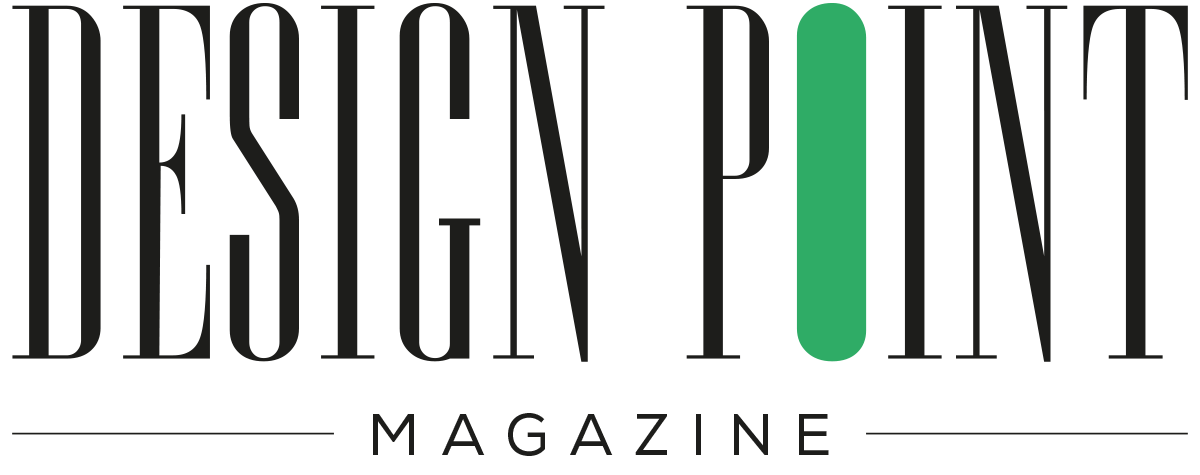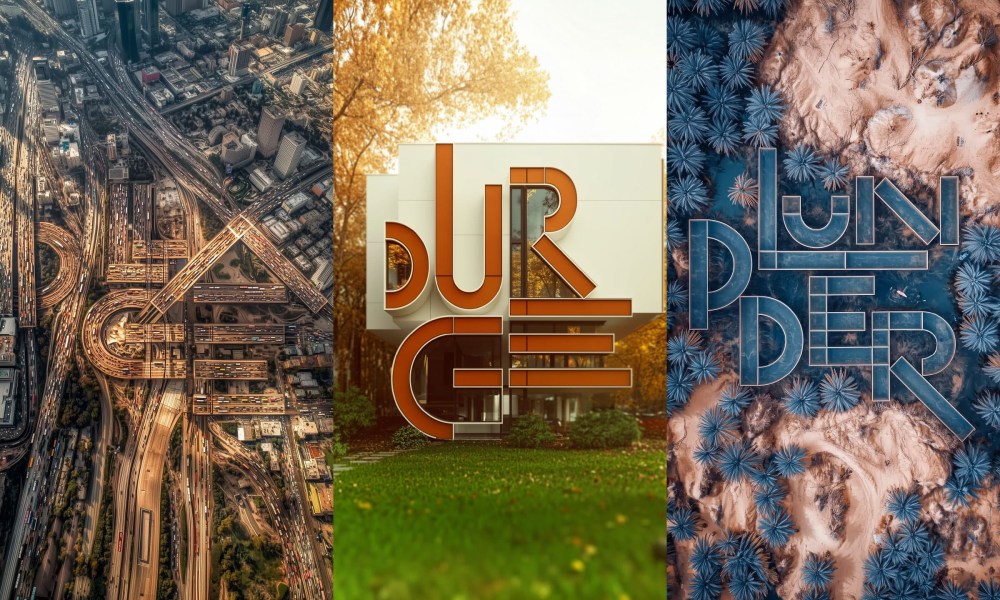Chicago’s Span Studio’s work reflects a passion for the built environment and the city they call home. You may remember several recent projects, including the IIT School of Architecture’s brand rollout and work for Sanctuary, a new urban greenspace in Chicago. This passion is reflected in the work of Span partner and design director John Pobojewski, who also happens to be an artist. Pobojewski’s most recent project, “Pillage Purge Plunder,” takes the design of urban spaces to an absurd and fantastical place using AI, letterforms, architectural language, and imagined environments.
Over the last decade, in his work as a designer, Pobojewski has worked with architects and urban planners across Asia and the Middle East. This work taught him so much about livability and sustainability, but he contends that we bear a much greater responsibility when designing at the scale of a city. “How does a city transform its ecosystem? How does it accommodate the diverse needs of millions of people, each from a cross-section of economic and social classes? How does it grow? How does it breathe? How is it resilient to disasters?” Pobojewski asks.
“Pillage Purge Plunder” interrogates these questions through a critique of urban design projects such as NEOM’s The Line. The ambitious and equally controversial concept out of Saudi Arabia has lofty goals to solve environmental and population density concerns. However, it also stands as one example of development for development’s sake. In Pillage Purge Plunder, Pobojewski created 360 AI visualizations that “push urbanism beyond the limits of reality.” Designed to be displayed in triptychs, Pillage Purge Plunder asks the viewer to think about the perils of rampant overdevelopment.
The project, shown at Chicago’s Typeforce gallery this spring, is a perfect Earth Day meditation on our insatiable appetite for development, the elevation of design above community needs, and our human tendency to aspire to mold our natural environment for our purposes.
Pobojewski was kind enough to answer some of my questions about his work and “Pillage Purge Plunder” specifically. Our interview below has been lightly edited for clarity and length.
“Pillage Purge Plunder” at Typeforce
I understand that a critique of NEOM’s The Line served as your inspiration for “Pillage Purge Plunder.” What specifically about these sorts of building/development projects sparked your idea?
These megadevelopments have a tremendous environmental and societal impact in their home countries. The stakes could not be higher — they should be considered holistically and thoughtfully throughout the design process so the proposals represent both civic and ecological good as much as possible. The Line is a great example of how that process can go wrong. Designers end up proposing a horrendously irresponsible concept for a city that will be a tremendous burden on natural resources simply because it “looks cool” or “looks innovative.” And of course, government leaders and investors take the bait.
Not every city design is this way — far from it! Responsible urban design is an incredible discipline, and I’ve been privileged to work alongside some of the best in the world, helping tell the stories behind their approach to urban issues worldwide through branded presentations and short films.
However, The Line represents to me this trend of thinking of the city as an “object” — like a sculpture or a painting. To me, this is a very destructive and narrow point of view. It exploits both people and resources only to serve a singular vision, when a city is ultimately a framework that evolves and responds to its people. That idea of stealing or pirating from future generations is what inspired the language used in the name of the piece.
In many ways, large-scale AI image engines like Midjourney are also exploitative, using artists’ work without their permission to make their own products more “successful.” It felt like a natural fit to use Midjourney technology as the “expression engine” behind this piece.
Urban design is necessary, but it’s not about forcing one willful design gesture onto them. Cities must be much more responsive.
What did your creative process look like? Were there any particular prompts that surprised you or challenged something about the process?
I’ve been experimenting with AI using open-source models like StableDiffusion and Flux via ComfyUI with mixed results, mainly because I was unhappy with how little impact I could have on the compositions created. When I dug deeper into the ControlNet tools for SD, I started getting results that were much more interesting to me, as they allow for a prompt image in addition to text prompts that can guide the end result. This inspired me to start using shapes and simple geometric forms to inform outputs.
With this piece, I really wanted to use Midjourney due to the alignment of the platform’s unauthorized use of artists’ work with the concept for the piece. As a happenstance, Midjourney put out a new technique called Retexturing that was very much inspired by Stable Diffusion’s ControlNet, which allowed for an image to be uploaded and used as a guide for the resulting image.
From there, it was just a matter of getting the prompts right. For the series of aerial landscapes, I used terms from satellite imagery including specifying elevation (“50m,” “500m,” etc) as well as descriptive terms of the type of geography I was looking for (“agriculture,” “river delta,” “desert,” etc.). For the city images, it was similar but more focused on urban conditions (“slum,” “trainyard,” “metropolis,” “megalopolis,” etc). For the architectural renderings, I leaned on the incredible quantity of architectural visualization that’s used to “sell” design projects — terms like “villa,” “luxury apartment building,” “modern design,” etc., which easily generated very recognizable images.
Process prompts, clockwise from top left: Agriculture, Polar Ice Caps, Commercial, Villa, Slum, Megapolis.
How did you go about conceptualizing the original letterforms? Was there anything from your original NEOM critique that served as a throughline?
For several years, I’ve been informally creating a series of works I call “Archetypes” that use letters to suggest physical spaces. These are all hand-composed and constructed out of really simple shapes. For this piece, I wanted something that had a lot of diagonal lines to be able to create interesting negative spaces for the AI diffusion to “fill in” within the compositions.
Getting the final compositions right took a while, with my daughter actually providing feedback as to what looked the best! From there, there were a lot of trials in preparing the source images so that they would be the most successful structure. Ultimately, white lines on a black field yielded the best results.
The Line didn’t have any particular influence on the design of the source letterforms; they were purely a visual delight on my end.
As a designer and artist who often blends new media and different technologies in your work, what do you think emerging technology (even tech that, on the surface, challenges the notion of what it means to be a designer by trade) has to teach designers and creatives about their craft?
I think it’s really important to acknowledge that “AI” does not necessarily mean “Midjourney.” There are many artists who have worked with machine learning for years — Memo Atkin, Mario Klingemann, Jake Elwes, Anna Ridler, and many others. These artists train their own data sets and explore machine learning as a medium, spending countless hours investigating, studying, and iterating, beyond a simple prompt.
I’ve been working in new media for a while, mainly through generative code like Processing, Open Frameworks, or Cinder. To me, technology is an incredible discipline that can open entirely new expressive possibilities to what art can be, and the role of the artist in creating it. Above all, craft remains at the forefront. The pursuit of exploration is always paramount, just like any other artistic discipline. This stands in stark contrast to Midjourney and similar image generation companies that are standing to profit off the work of other artists. While it is a form of machine learning, it’s neither the most interesting nor certainly the most ethical.
Ultimately, new technology offers designers entirely new dimensions to think about their work, over time, through countless iterations, over vast complexities, in a much more accessible way that can yield fascinating results. I certainly encourage all artists to explore it and see if it’s fruitful in their own work.
You identify as an “intermedia” artist. How does this differ from multimedia, or does it, in your mind?
My definition of “intermedia” comes from Dick Higgins, co-founder of the Fluxus movement, which states that the term represents work created between the traditional modes of artmaking. It’s about breaking down boundaries between a single medium or area of thought. To me, “multimedia” has become just another codeword for a specific type of work, mainly time-based or motion in form. We founded Span on the idea of “crossing boundaries” in graphic design, and I believe this is very much in thinking with “intermedia” — that one medium, one methodology is not necessary what defines an artist.
What do you hope people will take away from engaging with “Pillage Purge Plunder”?
I hope that people stop and think about the environmental and societal impacts that these massive construction projects have on our people and planet. Urban design is necessary, but it’s not about forcing one willful design gesture onto them. Cities must be much more responsive. After all, the best cities in the world are ultimately designed by many, never “one.”
There desperately needs to be a bright glimmer of hope fighting for a better future, and designers are uniquely qualified to be the ones stoking that flame.
In your artist’s statement, you ask this question: “Are we helping society steal from the present moment in order to feed the desire for a future that may never come?” In a time like right now (pick your poison: environmental, disinformation, authoritarianism, exploitation, racial injustice…), what role does design play? What questions should designers and other creatives ask themselves in their unique position?
In my opinion, design is ultimately an optimistic point of view of looking at the world. By creating new things, you inherently believe that our world can be better; that things can be improved. I think our society needs that now more than ever. While I’ll grant that it’s incredibly difficult at this present moment, it’s so important that we as a profession stay positive and committed to creating positive change in our work, in our studios, with our clients and collaborators. There desperately needs to be a bright glimmer of hope fighting for a better future, and designers are uniquely qualified to be the ones stoking that flame.
It’s tempting to be the ones complaining, the ones feeling hopeless. I feel it, I understand, and I’m guilty of it too. But right now our role has to be to amplify positive change – informing, imagining, and inspiring all of us to strive for a better way of life, both in our society and in our profession.
The post ‘Pillage Purge Plunder’ Uses Letterforms and AI to Wonder About the Limits of Urbanism appeared first on PRINT Magazine.

